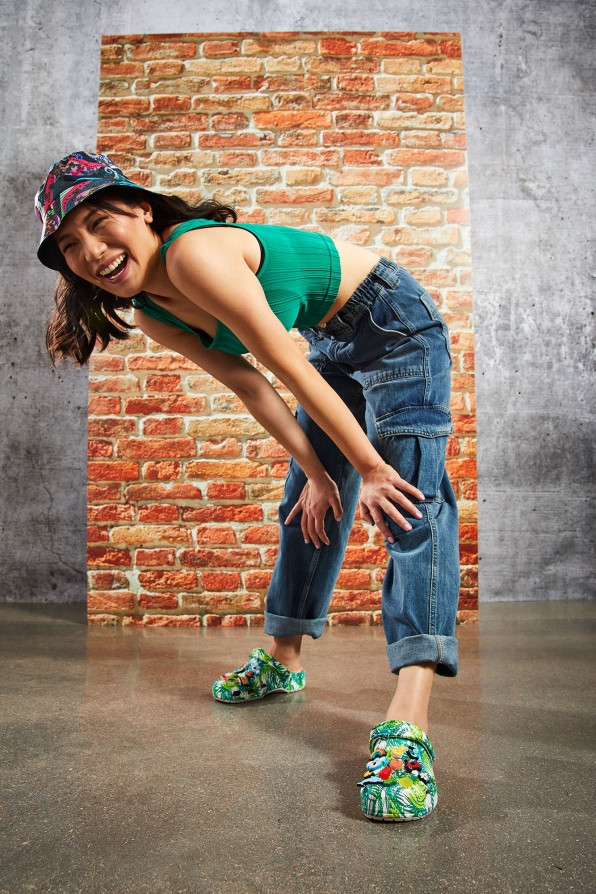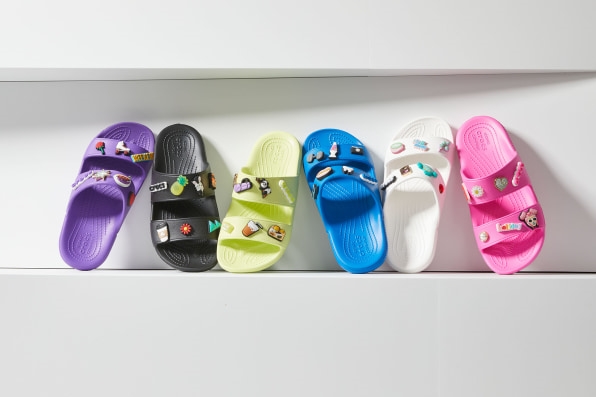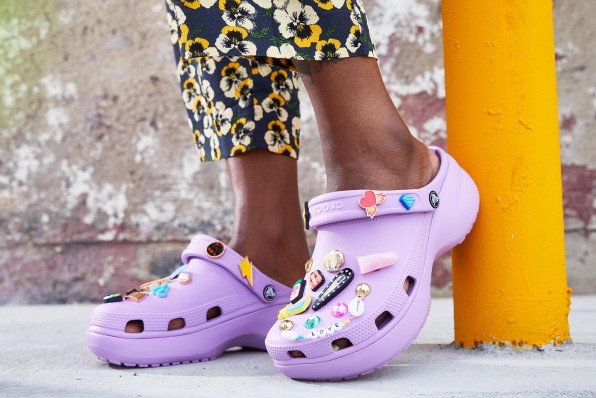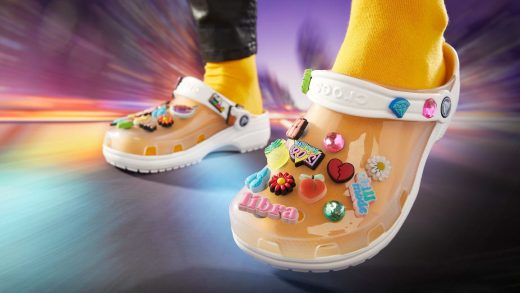‘Yes, we’re ugly, but we’re one-of-a-kind’: How Crocs went from laughingstock to red carpet
Nobody is neutral about Crocs. In the two decades since the clunky plastic clog first debuted, people have fallen squarely into one of two camps: Those who love the comfort and functionality, and those who mercilessly mock how hideous they are.
But since the pandemic started, Crocs has convinced more people to switch from haters to lovers. In 2020, the company’s revenues reached a record high of $1.4 billion, a 12.6% spike from the year before. During that time, Crocs’s stock was among the best-performing in the retail industry, with shares rallying by more than 260%. Part of the brand’s growth can be attributed to people craving comfort in the midst of lockdown, but part of it is also due to the legion of high-profile fans, including Priyanka Chopra, Justin Bieber, and Post Malone, all of whom have partnered with the brand in recent months.
At the heart of Crocs’s success lies some marketing wizardry. From the start, the brand has been aware of how polarizing its shoes are, inspiring feelings of disgust from many consumers. But rather than defend itself against these antagonists, it has harnessed the hatred to create a narrative about how the shoe represents radical inclusivity and individuality–values that are increasingly important, particularly among young people. For now, the message appears to be resonating, but as the brand becomes increasingly mainstream, it’s unclear whether Crocs will be able to count on shaming its haters to fuel its growth.

Shaming the haters
Most companies work hard to establish brand recognition with consumers—but since launching in 2002, Crocs has never had to do that. “We’ve never had trouble with brand awareness,” says Michelle Poole, Crocs’s president. “You can show our iconic silhouette throughout the world, and people everywhere can identify it as Crocs, which is unusual.
There were many consumers who quickly embraced the shoe, drawn largely to its practicality and comfort, including healthcare professionals, chefs, and kids. But the company’s biggest struggle was always figuring out how to expand its base and resonate with more consumers. Back in 2010, Time named Crocs one of the 50 worst inventions of all time because they were so ugly. In that story, Crocs’s then-CEO explained that the brand was trying out more palatable silhouettes, like ballet flats, and was quoted as saying, “If we make it a little bit more stylish, then we start to appeal to a larger audience.”
But around five years ago, the marketers at Crocs had a revelation: there was no point in trying to win over haters. Instead, they would focus on how unique the shoes were. “Yes, we’re ugly; yes, we’re polarizing,” says Heidi Cooley, Crocs’s CMO. “But importantly, we’re one-of-a-kind. And what we recognized is that this is exactly what resonated with some of our fans: They too see themselves as one-of-a-kind.”
Crocs launched a campaign in 2017 that focused on how much the brand had been bullied over the years, using spokespeople like Drew Barrymore and John Cena to speak about their own personal experiences with bullying. In many ways, the brand was calling its detractors bullies at a time when many organizations, from the Cartoon Network to the Federal Government, were launching anti-bullying campaigns.
The strategy seemed to work. After several years of losses, Crocs grew by 6% in 2018, and 13% the year after. By 2020, Crocs was described by many analysts as the “it” shoe of the pandemic, even as the rest of the retail industry as a whole was struggling.

Act fast, collaborate often
Crocs has also been quick to embrace its celebrity fans, many of whom style the shoes to fit their personal aesthetic: Diplo’s Crocs fit into his his psychedelic, hippy style; Zooey Deschanel wears hers with vintage dresses. Cooley says that the marketing team moves to quickly capitalize on the moment. “We don’t work with partners who aren’t authentic fans of the brand,” says Cooley. “We make sure that these influencers were already wearing our shoes before we approach them.”
These collaborations have been very successful, often selling out in days. And they’ve brought in thousands of new customers who likely never would have considered wearing the shoes before. The Post Malone clogs, for instance, came in black and pink, with a chunky sole and a drawcord that gave them an industrial chic look to match the musician’s hardcore tattooed aesthetic. Justin Bieber’s Crocs were lavender and covered with oversized charms, which he styled with streetwear. Meanwhile, actress Priyanka Chopra was photographed wearing Crocs that had been customized with glitter, and in 2020 she became the brand’s ambassador.
“What we love, as a brand, is that these people are so accepting of what we represent,” Cooley says. “They wear our shoes to disrupt peoples’ image of them. That, paired with our ability to be so versatile in terms of aesthetics, has brought new fans to the brand. It’s Diplo or Post Malone who has converted them.”
A number of companies have wanted to partner with Crocs to leverage the brand’s success and take advantage of its halo of individuality. While many fashion labels are focused on curating their collaborations and rigidly controlling their image, Crocs has embraced a wide range of partners. In recent months, it has partnered with KFC on clogs that actually smell of fried chicken; Benefit Cosmetics to create glittery pink clogs; Vera Bradley to create clogs covered in flowery patterns; and Madewell to create trendy tie-dye-printed clogs to pair with jeans.
In a bizarre twist, high-end fashion brands have also chosen to partner with Crocs, perhaps revealing how much has changed since the early days, when the shoes were seen as the antithesis of fashion and good taste. Barney’s partnered with Crocs to create punk-inspired clogs covered in spikes and metal embellishments that cost $90 and sold out almost immediately. Balenciaga partnered with Crocs on several collections, creating high-heeled and rain-boot versions. Demna Gvasalia, Balenciaga’s creative director, is known for his fascination with shoes that have strange proportions, and his partnership with Crocs sent the message to the fashion community that the clogs could be fashion-forward.
Lauren Bitar, head of insights at the analytics firm RetailNext, says there’s some danger to the shoe being too much of a fashion statement. “You don’t want your customers to be wearing your shoes ironically,” she says. “Otherwise, they will go the way of the Christmas sweater, which is not what you want as a brand.”
But Cooley says Crocs’ fundamental focus on inclusivity allows these diverse partnerships to make sense. “What connects our fans is that they’re inclusive,” she says. “They see themselves–regardless of whether they’re wearing KFC or Benefit, or whether they’re in Shanghai or Colorado–as individuals who are bold, confident, and willing to express themselves. Because our shoe is still polarizing, it takes courage to raise your hand and wear Crocs, so they have this unified acceptance of each other.”

What if there are no more haters?
Crocs’s strategy has been so successful that the shoes are increasingly mainstream. But this could represent a problem: What will Crocs represent when it has fully saturated the market? The brand is on a tear now, but eventually this growth will slow down, and the big question is what Crocs will do next. “People are going to eventually move on to the next thing to love, or hate, or love to hate,” says Bitar. “It could leave Crocs behind. It’s just a matter of how long this hockey stick of growth is going to last.”
Bitar points out that in order to grow over the last five years, Crocs has had to churn out lots of products and open stores. But if the tides of fashion should turn, Crocs will be stuck with too much inventory and expensive brick-and-mortar leases. “What people love comes and goes so much faster now because we’re constantly bombarded with stimuli,” says Bitar. “They need to be sensitive about not overinvesting in inventory. But if they plan ahead for a possible dip in business, I don’t see why Crocs can’t be a solid brand for years to come.” And in fact, the brand is no stranger to cutting back after overextending: In 2018, when the company was still losing money, it shuttered its manufacturing facilities to improve profitability, working with third party factories instead.
Cooley says her team at Crocs spends a lot of time thinking about how the brand has focused on this narrative of polarization, and how it could potentially evolve. But she also points out that while Crocs has more fans than ever, there are still plenty of people who openly talk about how much they dislike the shoe. “I think we will have to change the narrative around the brand in the future, but that point is further out than most people realize,” she says. “There is still a lot of negative sentiment around our brand, which we love to capitalize on. That’s what’s going to keep the conversation going for us.”
(55)



